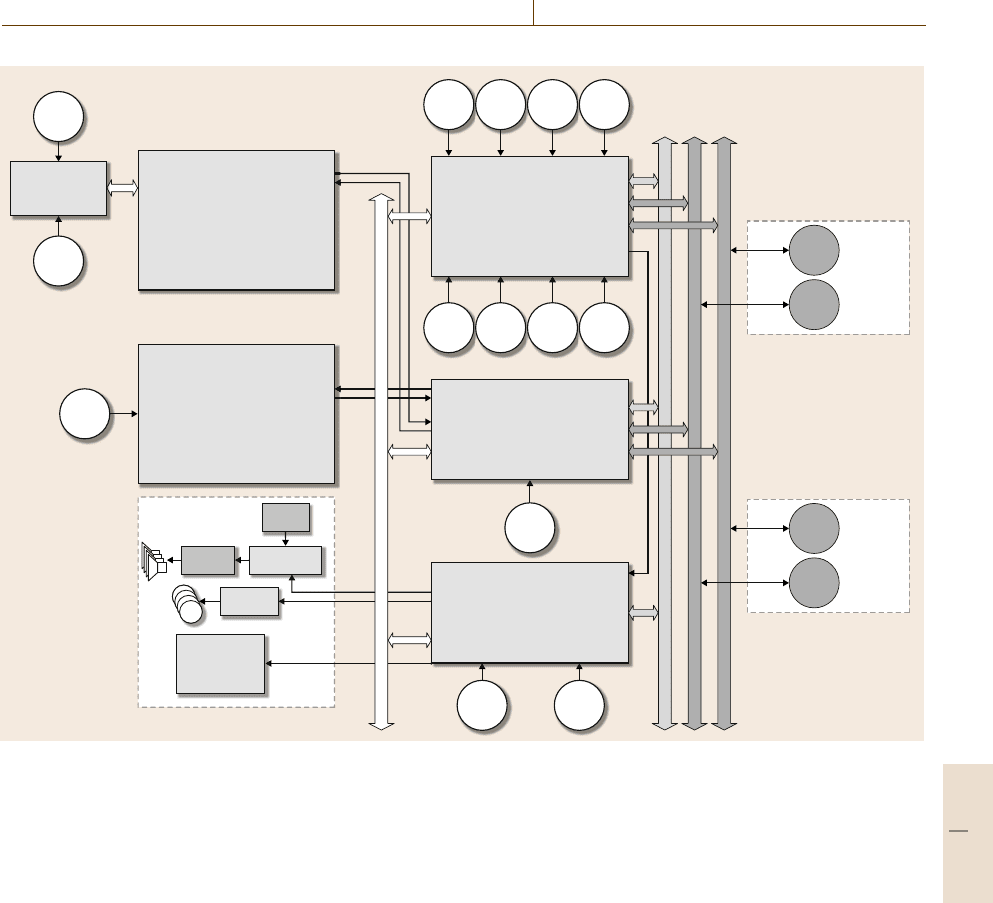Nof S.Y. Springer Handbook of Automation
Подождите немного. Документ загружается.


Vehicle and Road Automation 66.2 Integrated Vehicle-Based Safety Systems (IVBSS) 1175
Serial
RDCW system CAN bus (500K)
Nissan vehicle ECU CAN bus (500K)
Radar CAN bus 1 (500K)
Radar CAN bus 2 (500K)
Navigation
module
Curve speed
warning (CSW)
module
Lateral drift
warning (LDW)
module
Driver
display
Data acquisition
system (DAS)
module
Situational
awareness
module (SAM)
Driver vehicle
interface (DVI)
module
Forward
radar
Cell
phone
detect
GPS
antenna
ADAS
map
Com-
ment
PB
Cellular
antenna
Front
left
Front
right
Side
radar
Left
side
Right
side
Steering
wheel
angle
Inertial
sensors
Driver
face
camera
LSW
sensi-
tivity
Gyro
CSW
sensi-
tivity
CCD
LDW
camera
OEM
radio
DVI
DAS
forward
camera
Audio
mic
USB
Serial
Serial
Serial
Panel link
Warning enabled
Audio matrix
module
OEM
amplifier
Haptic
controller
Fig. 66.6 RDCW system architecture (after [66.15]) (PB – push button)
Understanding driver behavior is also important
in minimizing nuisance or false alerts, which not
only cause stress and irritation to the driver but may
also cause driver distraction. For instance intentional
lane changes involve particular actions by the driver
which may resemble actions taken when an accident
is imminent. Therefore precisely differentiating driver
behaviors is necessary.
How is human factors research conducted? Vehi-
cle simulators used by NHTSA, car manufacturers,
research centers, and driver training centers are valu-
able in the initial research and development (R&D) of
vehicle technologies. In the continuum of assessment
methodologies, simulators offer the greatest range of
possible scenarios and driving conditions within a safe
setting and are at the lowest end in terms of noncap-
ital resource expenditures. Modular design simulators
have interchangeable cabs which can be configured for
different vehicle models. Multistation driving simulator
allows one controller/instructor to control multiple driv-
ing stations, enabling simultaneous multiple simulation
runs. Recently Toyota introduced its new simulator that
imitates speed, acceleration, deceleration, comfort con-
ditions, and conditions at intersections. The simulator
is comprised of eight high-precision projectors within
a large dome which has a turntable, tilt mechanism, and
vibration equipment. The dome is on a track that allows
forward, backward, and side-to-side movement. Jaguar
and Land Rover’s engineering facility in the UK also in-
troduced a state-of-the-art simulator that relies more on
virtual reality to create three-dimensional (3-D) vehicle
exteriors and interiors [66.16]. Less sophisticated sim-
ulators might consist of a steering wheel connected to
a monitor displaying roadway images.
Part G 66.2

1176 Part G Infrastructure and Service Automation
A proving ground is the next step in the develop-
ment and testing process. Before systems are tested on
the road, it is prudent to test them in a more controlled
environment. Most automakers have their own proving
ground or use an independent facility. These facilities,
like simulators, range in size and number of features.
Some facilities may have 50 miles of roadway of vary-
ing types. After the system has undergone additional
modifications and fine-tuning, realistic driving scenar-
ios should be evaluated.
Field testing on actual roadways is resource in-
tensive because multiple vehicles need to be fitted
out with the technologies and then test subjects re-
cruited to drive the vehicles for a certain number of
weeks. Usually baseline data without the use of assis-
tance or warning systems to reveal a driver’s natural
driving behavior are gathered initially and then com-
pared against their behavior after the systems are turned
on.
To be able to generalize test results in field tests,
a sufficient number of test subjects should be se-
lected from a diverse population in terms of age,
gender, and driving experience; testing should be
conducted under a variety of weather and traffic con-
ditions, different roadway geometry, and freeway and
local roadways in urban, suburban, and rural settings;
and, optimally, it should be performed in real-world
settings.
66.3 Vehicle Infrastructure Integration (VII)
In order to connect drivers, roads, and vehicles, the
USVehicle Infrastructure Integration or VII has been
established. VII isenvisioned to be a national communi-
cations infrastructure and will enable vehicle-to-vehicle
and vehicle-to-roadside communications. Thededicated
short-range communications (DSRC)5.9 GHz system,
a reliable short-range wireless technology, has been
designated for transportation and public safety applica-
tions. What will be required will be the development of
national standards for interoperability, close collabora-
tion among USDOT, state DOTs, and vehicle makers,
the development of key technologies, and the resolution
of political, institutional, legal, economic, and social
issues connected with the infrastructure.
The four phases of the VII initiative are [66.17]:
1. Case and application development planning
2. Proof-of-concept testing
3. Prototype development, testing, and analysis.
Human factor issues will be addressed, real-world
applications refined and expanded, and institutional
challenges considered, such as citizen anonymity,
privacy, and security.
4. The final step is deployment readiness and support,
including identifying the resources, policies, and
governance necessary to move forward.
Phase 1 has been completed, and phase 2 testing
is now underway, with California and Michigan hav-
ing the most VII test-bed infrastructure. Also, a large
demonstration of VII is planned in New York City in
November of 2008 at the 2008 World Congress and ITS
America 2008 annual meeting.
66.3.1 VII Benefits
VII safety benefits are brought about by collision
warning systems on highways and local arterials, inter-
section collision avoidance technology, traffic violation
warnings, and roadway curve warning; for example
a broken-down vehicle on an interstate could send wire-
less messages to an approaching semitrailer truck, and
on to the cars behind it. According to Bob Lange, exec-
utive director of vehicle structure and safety integration
at General Motors Corp, it could even apply the car’s
brakes automatically if the driverbehind thetruck isdis-
tracted. If there is a potential conflict at an intersection,
the roadside infrastructure could transmit appropriate
messages to the vehicles approaching the intersection,
and the vehicles would then alert the drivers. Similarly,
warnings would be issued if another car is in a vehi-
cle’s blind spot, or if a lane change is required due to
construction work.
Other benefits enhance the mobility of drivers and
their access to desired destinations. In-vehicle naviga-
tion systems direct drivers by voice to their destinations
and provide convenient real-time turn-by-turn direc-
tions. Some systems have voice recognition capability
so that the driver need not manually input the des-
tination, and other systems assist drivers optimize
their trips and can incorporate personal preferences
such as avoiding highways. In-vehicle information sys-
tems assist drivers find destinations such as hotels,
restaurants, and gas stations, and may even have real-
time information comparing gas prices at different
stations. These systems can also help drivers avoid con-
Part G 66.3

Vehicle and Road Automation 66.4 Conclusion and Emerging Trends 1177
gested roads by providing real-time incident and delay
information.
Vehicles, acting as information probes, would col-
lect and transmit data about traffic and road conditions
anonymously to the roadside infrastructure, which
would then process the information and send it out to
the vehicles on the road; users of the data could be
charged a subscription fee, making VII a viable busi-
ness opportunity for the private sector. This information
can also be used by transportation planners and traf-
fic management center (TMC) operators for corridor
management tasks.
66.3.2 VII Risks
Historically the majority of potential technology users
will only adopt once the very early users, who are will-
ing to experiment, try and approve a new technology;
cellphones, for instance, took 20years before achiev-
ing widespread consumer acceptance [66.18]. The VII
infrastructure will take a large amount of resources to
deploy, about US$6–8billion, which will likely require
Congressional approval or a combination of govern-
ment and private-sector involvement.
The primary risks for VII are thefollowingtechnical
and market risks.
Technical risks include: the need to integrate mul-
tiple technologies; ensuring connectivity within the
DSRC network, and a determination of how to handle
the data generated by the system; the development of
a technology that will be able to perform real-time ana-
lysis of data from many different input sources. There
is also a question over whether the technologies will be
effective if only a portion of users adopt them. Also,
how the entire country will be mapped, and how VII
can be flexibly applied to local needs, will need to be
determined.
Marketrisks includethe identificationof fundingfor
the system, user acceptance and willingness-to-pay is-
sues, and difficulty in accurately assessing system value
until after the system has been implemented. From
the automakers’ perspective, the introduction of new
features and innovations is always risky, particularly
a safety feature which could increase the likelihood of
lawsuits. Therefore the business case for automakers to
incorporate these systems into their vehicles must be
especially strong.
Because of the uncertainty with regards to which
technologies in which form will receive the greatest
user acceptance, an open architecture would be rec-
ommended. Also, the development and use of industry
standards will be important. Industry standards such as
local interconnect network and media-oriented systems
transport are being created for communication buses to
link electronic control units, subsystems, and sensors.
Automotive open system architecture (AUTOSAR),
a partnership of auto manufacturers, suppliers, and
tool developers, is attempting to become the de facto
standard-setting organization for the auto industry on
a global basis. AUTOSAR seeks to minimize barriers
between functional domains and networks indepen-
dently from the hardware and to manage the increasing
complexity of the technology. AUTOSAR is an open
and standardized global automotive software architec-
ture with the following motto: Cooperate on standards,
compete on implementation [66.19].
66.4 Conclusion and Emerging Trends
While fully automated driverless vehicles and flying
cars are many years away, ITS technologies have been
increasing the capabilities, intelligence, and safety of
the automobile. An early generation of such vehicles
can be seen in Figs. 66.7 and 66.8. The percentage
of total vehicle value accounted for by electronics and
software is currently 15% for compact cars, 28% for
luxury cars, and 47% for hybrid cars, and is expected
to rise yearly. The continuing need for mobility and
Fig. 66.7 Defense Advanced Research Projects Agency
(DARPA) car at the Intelligent Vehicle Conference 2008,
Eindhoven
Part G 66.4

1178 Part G Infrastructure and Service Automation
safety enhancements will ensure the growth of the value
of electronics and software; the increase is estimated
to be about 150%, from US$187billion in 2002 to
US$464 billion in 2015 [66.20].
Much progress has already been made in deploy-
ing individual ITS technologies, and many mobility
and safety benefits are already being experienced.
The National ITS Architecture has been the unifying
framework allowing the disparate transportation tech-
nologies to work together; and vehicle infrastructure
integration will be the engine by which vehicle-to-
vehicle and vehicle-to-roadside communications will
take place. Once the Integrated Vehicle-Based Safety
Systems initiative is completed and the safety-oriented
ITS technologies are implemented, even more safety
benefits are expected to be realized.
Fig. 66.8 Carnegie Mellon entry to the DARPA 2007
Urban Challenge competition, Boss, Tartan racing robot
(courtesy of Tartan Racing, Carnegie Mellon University)
66.5 Further Reading
•
J. Baber, J. Kolodko, T. Noel, M. Parent, L. Vlacic:
Cooperative autonomous driving: intelligent vehi-
cles sharing city roads, IEEE Robot. Autom. Mag.
12(1), 44–9 (2005)
•
S. Bahler, J. Kranig, E. Minge: Field test of non-
intrusive traffic detection technologies. In: Trans-
portation Research Record 1643, ed. by Transporta-
tion Research Board (National Research Council,
Washington 1998) pp.161–170
•
D. Braid, A. Broggi, G. Schmeidel: The TerraMax
autonomous vehicle, J. Field Robot. 23(9), 693–708
(2006)
•
J.L. Campbell, C.M. Richard, J.L. Brown, M. Mc-
Callum: Crash Warning System Interfaces: Human
Factors Insights and Lessons Learned (Battelle
Center for Human Performance and Safety, Seattle
2006)
•
K. Catchpole, J.D. McKeown, D.J. Withington:
Localizable auditory warning pulses, Ergonomics
47(7), 748–771 (2004)
•
US Department of Transport: Crash Avoidance
Metrics Partnership (CAMP): Enhanced digital
mapping project final report; US Department of
Transport Tech. Rep. (2004)
•
US Department of Transport: Crash AvoidanceMet-
rics Partnership (CAMP): Vehicle safety communi-
cations project task 3 final report; US Department of
Transport Tech. Rep. (2005)
•
A. Houser, J. Pierowicz, D. Fuglewicz: Concept
of Operations and Voluntary Operational Require-
ments forLane Departure Warning Systems (LDWS)
On-Board Commercial Motor Vehicles, FMCSA-
MCRR-05-005 DTMC75-03-F-0087 (Federal Mo-
tor Carrier Safety Administration, Washington
2005)
•
A. Houser, J. Pierowicz, R. McClellan: Concept
of Operations and Voluntary Operational Require-
ments for Forward Collision Warning Systems
(CWS) and Adaptive Cruise Control (ACC) Systems
On-Board Commercial Motor Vehicles, FMCSA-
MCRR-5-007 DTMC75-03-F-0087 (Federal Motor
Carrier Safety Administration, Washington 2005)
•
International Organization for Standardization: In-
telligent transportation systems – forward vehicle
collision warning systems – performance require-
ments and test procedures, Draft International
Standard ISO/DIS 15623 (2002)
•
International Organization for Standardization: In-
telligent transportation systems – lane depar-
ture warning systems – performance requirements
and test procedures, Draft International Standard
ISO/DIS 17361 (2004)
•
International Organization for Standardization: In-
telligent transportation systems – lane change
decision aid systems – performance requirements
and test procedures, Draft International Standard
ISO/DIS 17387 (2006)
•
ITS Public Safety:
http://www.its.dot.gov/pubsafety/index.htm(last ac-
cessed on May 5, 2009)
Part G 66.5

Vehicle and Road Automation 66.5 Further Reading 1179
•
IVBSS Project Team: Preliminary Functional Re-
quirements for the Integrated Vehicle-Based Safety
System (IVBSS) –Heavy-Truck Platform (University
of Michigan Transportation Research Institute, Ann
Arbor 2007)
•
IVBSS Project Team: Preliminary Performance
Guidelines for a PrototypeIntegratedVehicle-Based
Safety System (IVBSS) – Light-Vehicle Platform
(University of Michigan Transportation Research
Institute, Ann Arbor 2007)
•
R.J. Kiefer, D. LeBlanc, M. Palmer, J. Salinger,
R. Deering, M. Shulman: Development and Val-
idation of Functional Definitions and Evaluation
of Procedures for Collision Warning/Avoidance
Systems, NHTSA Rep. HS 808 964 (National
Highway Traffic Safety Administration, Washing-
ton 1999)
•
R.J. Kiefer, D. LeBlanc, M. Palmer, J. Salinger,
R. Deering, M. Shulman: Forward Collision Warn-
ing Systems: Development and Validation of Func-
tional Definitions and Evaluation Procedures for
Collision Warning/Avoidance Systems,Rep.DOT-
HS-808-964 (Department of Transportation, Wash-
ington 1999)
•
R.J. Kiefer, M.T. Cassar, C.A. Flannagan, D.J.
LeBlanc, M.D. Palmer, R.K. Deering, M.A. Shul-
man: Forward Collision Warning Requirements
Project: Refining the CAMP Crash Alert Timing
Approach by Examining “Last-Second” Braking
and Lane Change Maneuvers Under Various Kine-
matic Conditions (2003)
•
D. LeBlanc: Road DepartureCrashWarningSystem
Field Operational Test – Methodology and Results,
Rep. UMTRI-2006-9-1 (University of Michigan
Transportation Research Institute, Ann Arbor 2006)
•
R. Madhavan, E.R. Messina, J.-S. Albus: Intelli-
gent Vehicle Systems: A 4D/RCS Approach (Nova
Science, Hauppauge 2007)
•
W.G. Najm, J.D. Smith: Development of Crash Im-
minent Test Scenarios for Integrated Vehicle-Based
Safety Systems (IVBSS), Department of Transport
VNTSC-NHTSA-07-01 DOTHS 810757 (National
Highway Traffic Safety Administration, Washing-
ton 2007)
•
Y. Nakanishi, J. Western: Ensuring the security of
transportation facilities: An evaluation of advanced
vehicle-identification technologies, Transportation
Research Board 84th Annual Meeting (2005), CD-
ROM
•
NHTSA: Preliminary Assessment of Crash Avoid-
ance Systems Benefits (National Highway Traffic
Safety Administration, Washington 1996), Version
II, Chap. 3
•
D. Pomerleau, J. Everson: Run-Off-Road Collision
Avoidance Using IVHS Countermeasures – Final
Report, NHTSA Rep. DOT HS 809 170 (National
Highway Traffic Safety Administration, Washing-
ton 1999)
•
J.R. Sayer, J. Devonshire, C.A. Flannagan: Ef-
fects of Secondary Tasks on Driving Performance,
Rep. UMTRI-2005-29 (The University of Michigan
Transportation Research Institute, Ann Arbor 2005)
•
A. Stewart: The development of driverless au-
tonomous vehicles, EngineerIT Nov/Dec, 50–52
(2006)
•
S. Szabo, R. Norcross: Recommendations for objec-
tive test proceduresfor road departurecrash warning
systems, Memorandum to NHTSA (2003)
•
S. Talmadge, R. Chu, C. Eberhard, K. Jordan,
P. M offa: Development of Performance Specifica-
tions for Collision Avoidance Systems for Lane
Change Crashes, NHTSA Tech. Rep. (National
Highway Traffic Safety Administration, Washing-
ton 2001)
•
A.K. Tan, N.D. Lerner: Multiple Attribute Evalu-
ation of Auditory Warning Signals for In-Vehicle
Crash Avoidance Warning Systems (National High-
way Traffic Safety Administration, Washington
1995)
•
C.E. Thorpe: Side Collision Warning System
(SCWS) Performance Specifications for a Transit
Bus, Federal Transit Administration under Pen-
nDOT 62N111 Project TA (Federal Transit Admin-
istration, Washington 2002)
•
S.M. Turner, W.L. Eisele, R.J. Benz, D.J. Hold-
ener: Travel Time Data Collection Handbook,
USDOT/FHWA-PL-98-035 (Federal Highway Ad-
ministration, Washington 1998)
•
University of Michigan Transportation Research In-
stitute: Integrated Vehicle-Based Safety Systems
(IVBSS), First Annual Report (US Department of
Transport, 2007)
•
C. Urmson, W. Whittaker: Self-driving cars and the
urban challenge, IEEE Intell. Syst. 23(2), 66–68
(2008)
•
US Department of Transportation: IVBSS Program
Plan,
http://www.its.dot.gov/ivbss/ivbss_workplan.htm
(2005), retrieved June 18, 2007
•
US Department of Transportation: Intelligent vehi-
cle initiative final report, Tech. Rep. FHWA-JPO-
05-057 (2005)
Part G 66.5

1180 Part G Infrastructure and Service Automation
•
US Department of Transport:
http://www.its.dot.gov/vii/index.htm (last accessed
May 5, 2009)
•
VII Coalition Information:
http://www.vehicle-infrastructure.org (last accessed
May 5, 2009)
References
66.1 Traffic Safety Facts 2006, DOT HS 810 809 (NHTSA,
2006), updated 2008
66.2 Annual study shows traffic congestion worsening
in cities large and small, Texas Transportation In-
stitute Press Release Sept. 18, 2007
66.3 US Department of Transport ITS Benefits Database:
http://www.benefitcost.its.dot.gov (2009)
66.4 National ITS Architecture:
http://www.iteris.com/itsarch/ (2009)
66.5 Y.J. Nakanishi: Introduction to ITS. In: Economic
Impacts of Intelligent Transportation Systems: In-
novations and Case Studies, ed. by E. Bekiaris,
Y. Nakanishi (Elsevier, Oxford 2004) pp. 3–16,
Chap. 1
66.6 J. Njord, J. Peters, M. Freitas, B. Warner, K.C. Allred,
R. Bertini, R. Bryant, R. Callan, M. Knopp,
L. Knowlton, C. Lopez, T. Warne: Safety Appli-
cations of Intelligent Transportation Systems in
Europe and Japan (US Department of Transport,
2006)
66.7 European Commission: http://www.prevent-ip.org/
(2008)
66.8 IVBSS Project Team: Preliminary Functional Re-
quirements for the Integrated Vehicle-Based Safety
System (IVBSS) – Light-Vehicle Platform (University
of Michigan Transportation Research Institute, Ann
Arbor 2007)
66.9 R.J. Kiefer, M.T. Cassar, C.A. Flannagan, D.J. LeBlanc,
M.D. Palmer, R.K. Deering, M.A. Shulman: Forward
Collision Warning Requirements Project Final Re-
port – Task 1, NHTSA Rep. HS 809 574 (National
Highway Traffic Safety Administration, Washington
2003)
66.10 University of Michigan Transportation Research In-
stitute and General Motors: Automotive Collision
Avoidance System (ACAS) Field Operational Test –
Methodology and Results, NHTSA Rep. HS 809 901
(National Highway Traffic Safety Administration,
Washington 2005)
66.11 General Motors, Delphi Electronic Systems: Au-
tomotive Collision Avoidance System (ACAS) Field
Operational Test – Final Program Report,NHTSA
Tech. Rep. DOT HS 809 866 (National Highway Traf-
fic Safety Administration, Washington 2005)
66.12 General Motors: Automotive Collision Avoidance
System Field Operational Test: Final Program Re-
port, US Department of Transport Rep. DOT HS
809 886 (US Department of Transport, Washington
2005)
66.13 D. LeBlanc, J. Sayer, C. Winkler, S. Bogard, J. De-
vonshire, M. Mefford, M.L. Hagan, Z. Bareket,
R. Goodsell, T. Gordon: Road Departure Crash
Warning System (RDCW) Field Operational Test –
Final Report (National Highway Traffic Safety Ad-
ministration, Washington 2006)
66.14 L.R. Shelton: Statement before the subcommit-
tee on highways and transit, Committee on
Transportation and Iinfrastructure, US House of
Representatives (2001), http://www.nhtsa.dot.gov/
nhtsa/announce/testimony/distractiontestimony.
html
66.15 University of Michigan Transportation Research In-
stitute, Visteon, AssistWare Technologies Inc.: Road
Departure Crash Warning Field Operational Test:
Interim Report on Road Departure Crash Warning
Subsystems (US Department of Transport, Washing-
ton 2003)
66.16 J. Challen: Reality bytes, Automot. Test. Technol.
Int. March, 48–51 (2008)
66.17 IVI Final Report: Saving Lives Through Advanced
Vehicle Safety Technology (2005)
66.18 Lessons Learned and their Impact on VII Applica-
tions in VII: An Alternative Perspective (Northeast-
ern University, 2007)
66.19 Autosar: http://www.autosar.org/ (Munich 2008)
66.20 J. Gunn: Speculate to communicate: The surge of
in-car electronics, Traffic Technol. Int. Feb/Mar
(2008)
Part G 66

1181
Air Transporta
67. Air Transportation System Automation
Satish C. Mohleji, Dean F. Lamiano, Sebastian V. Massimini
The air transportation system infrastructure is
comprised of communication, navigation, surveil-
lance, and air traffic management systems, and
is known as the National Airspace System. This
chapter describes the current very high-frequency
and high-frequency modes of communication,
very high-frequency omnidirectional range, dis-
tance measuring equipment, and instrument
landing systems for navigation/guidance to the
aircraft, and primary, as well as secondary radars,
for surveillance. The two primary functions of
the ground-based air traffic management sys-
tem, viz. traffic flow management for strategic
air traffic planning and air traffic control for
safe movement of aircraft, are discussed in
detail. This chapter also addresses the limited
role of automation in both the aircraft cockpit
and the ground-based air traffic management
system.
67.1 Current NAS CNS/ATM
Systems Infrastructure ..........................1183
67.1.1 Air/Ground Communications
Systems and Functions................ 1184
67.1.2 Navigation and Guidance Systems 1186
67.1.3 Modes of Navigation................... 1189
67.1.4 ATC Surveillance Systems
and Aircraft Tracking .................. 1190
67.1.5 Aircraft Tracking ......................... 1192
67.1.6 Air Traffic Management Functions 1192
67.2 Functional Role
of Automation in Aircraft
for Flight Safety and Efficiency ..............1194
67.3 Functional Role of Automation
in the Ground System
for Flight Safety and Efficiency ..............1195
67.3.1 Minimum Safe Altitude Warning... 1195
67.3.2 Conflict Alert.............................. 1195
67.3.3 User Request Evaluation Tool ....... 1196
67.3.4 Traffic Management Advisor ........ 1196
67.4 CNS/ATM Functional Limitations
with Impact on Operational Performance
Measures .............................................1196
67.4.1 Current Separation Minima
for Controlled IFR Aircraft ............ 1197
67.4.2 Flight Safety Assessment Metrics .. 1199
67.4.3 Determination of Airport Capacity 1199
67.4.4 Aircraft Delays
to Measure Operational Efficiency 1202
67.4.5 Measuring Controller Workload .... 1202
67.5 Future Air Transportation
System Requirements
and Functional Automation...................1203
67.5.1 Automation Approach to Meet
Future Air Transportation System
Requirements ............................ 1204
67.5.2 Development of Automated
Functional Capabilities ............... 1204
67.6 Summary .............................................1211
References ..................................................1212
The US civil air transportation system today handles
over 700million passengers and 40 billion revenue ton
miles of cargo annually that require about 23million
aircraft operations. Each aircraft operation represents
a flight from take off to touch down between its
departure and destination airports. This number is fore-
casted to reach a level of 35million operations by the
year 2025. Although the air transportation system has
recorded a very high level of safety over the years, the
continued growth in demand for air traffic services has
created operational inefficiencies, which result in signif-
icant flight delays and lost revenue for the users. Today,
a majority of decisions in the aircraft and in the ground
control system are manual. The human decision making
Part G 67

1182 Part G Infrastructure and Service Automation
is intensivefor the pilots andcontrollers interms oftheir
workloads, and will become unmanageable as traffic
levels grow. In order to deal with the traffic growth, the
future air transportation system will require increased
automation of air/ground functions to enhance safety,
capacity, and flight efficiency while reducing delays and
workload.
The performance of the air transportation system
is measured by four key metrics relating to safety, ca-
pacity, flight efficiency/delays, and workload. Because
aircraft safety is of the utmost importance, the US Gov-
ernment has established regulations that require the
aircraft to maintaina minimum separationdistance from
other aircraft. These separation minima vary with the
phases of flight. Explanations of the separation min-
ima and their influence, as well as limitations on flight
operations, are provided. How the use of automation
could in the future overcome these limitations is also
discussed.
Effortsare underway to define concepts for the next-
generation (NextGen) air transportation system in the
USA, and the Single European Sky air traffic man-
agement (AT M) research project in Europe. The Joint
Planning and Development Office, mandated by the US
Congress, is charted to develop NextGen concepts for
the years 2025 and beyond. The goals and requirements
of the NextGen system are presented. Also discussed
is the ongoing research and development of new satel-
lite technologies, including data link and satellite-based
navigation and surveillance, as well as the needed au-
tomation of ground-based decision support functions.
It is expected that enhanced automation in the aircraft
and in the ground system will provide safe and efficient
services to a significantly higher number of aircraft op-
erations in the future.
The civil air transportation system is an essential
component of the global economy. It is required for
timely movement of people and cargo. Until now, air
travel has been the safest mode of transportation per
passenger mile. Because of the cost, air transportation
has not been the primary mode of transportation for
long-distance travel in most countries, even though it
has been widely used in the USA. However, the demand
for air travel around the world is now increasingat a fast
pace to meet multinational commerce needs. For glob-
ally harmonized aircraft operations, the International
Civil Aviation Organization (ICAO), in collaboration
with National Civil Aviation Authorities (CAA), has
established standards and operating procedures to be
followed by all aircraft operators and air traffic service
providers.
In the US, the National Airspace System (NAS)is
a complex system of human-centric systems providing
communication, navigation, and surveillance (CNS),
and air traffic management (AT M) services to air-
craft flying passengers and cargo. During 2006, over
700million passengers used NAS, and the demand for
air travel is expected to increase beyond one billion pas-
sengers by the year 2015. The annual cargo revenue ton
miles exceeded 40billion in 2006 [67.1], and is contin-
uing to grow with the significant demand for goods and
services.
In order to meet the challenges of greater demand
for air travel, it is imperative to have an air trans-
portation system that not only maintains or enhances
safety, but also provides efficient flight operations.
The current aircraft operations and the air traffic con-
trol (ATC ) services are primarily manual open loop,
where the pilots in the aircraft and controllers on the
ground interactively make decisions based on the avail-
able information. The safety of the aircraft in the
air is provided by adhering to the established dis-
tance separation rules or separation minima in both
the horizontal and vertical domains. Thus, although
safety is assured, these separation requirements be-
tween aircraft often adversely impact the efficient use
of airport and airspace capacity, thereby resulting in
flight delays and creating extensive workload for the
humans operating the system. With the ever-growing
demand for air traffic services, as these capacity re-
sources become scarce, there is a need to develop
closed-loop feedback control NAS capabilities that can
provide automated decision support to maximize capac-
ity, enhance flight efficiency, and reduce pilot/controller
workload by minimizing reliance on cognitive decision
making.
This chapter describes the current NAS CNS/ATM
infrastructure, and the extent of the role that automation
plays in specific aircraft- and ground-based functions
for managing and controlling traffic. The limitation of
these functions is discussed with their impact on flight
safety, airspace/airport capacity, aircraft operational ef-
ficiency, and operator workload. The requirements for
the future air transportation system are presented, not
only to overcome the shortcomings of the current sys-
tem, but alsoto meet the service demandsof futureusers
effectively. The ongoing application of automated key
functions to meet the future system requirements are
presented to address hybrid automation/human decision
making in the cockpit and on the ground.
The scope of the contents presented here is limited
to an understanding of how the automated functions-
Part G 67

Air Transportation System Automation 67.1 Current NAS CNS/ATM Systems Infrastructure 1183
generated information helps manual decisions today,
and how automation will generate most decisions (ex-
cept those that are safety critical) in the future for
strategic planning and tactical operations during all
phases of flight. Any consideration of the use of au-
tomation in design and control of the aircraft (except
for safe navigation and efficient energy management),
or a discussion of the US Government programs to
upgrade and automate ground systems, is beyond the
scope of this chapter.
67.1 Current NAS CNS/ATM Systems Infrastructure
The current NAS infrastructure is comprised of a CNS
system architecture, and the AT M system that is de-
pendent upon an integrated system of airports and
ATC facilities. The ground-based ATM system includes
data/information acquisition and processing as well as
display capabilities supporting people in making deci-
sions to manage and control aircraft operations. The
CNS architecture deploys:
1. Very high-frequency (VHF) voice/data communica-
tion over the continental USA, and high-frequency
(HF) communication in the polar region and over
the ocean for air/ground communication
2. VHF omnidirectional range (VOR) and dis-
tance measuring equipment (DME): ground-based
navaids for navigation over pre-established routes,
with precision landing guidance to primary airports
provided by the instrument landing system (ILS),
NDBNDB
Navigation
ground-based NAVAIDS
ATM
Surveillance
radar
Communication
voice
Airline
dispatch
VHF
voice
VOR/DME
VHF/HF
voice
TRACON/ATCT
AT C
ILS
Fig. 67.1 NAS CNS/ATM infrastructure
and nonprecision landing guidance available from
VORs and nondirectional beacons (NDB)
3. Surveillance to locate and track the aircraft pro-
vided by the primary and secondary surveillance
radars (SSR). The weather radars detect and pro-
vide weather and wind information in some aircraft
cockpits and to the ground system.
The AT M system has two distinct functions: traffic
flow management (TFM)andAT C. The TFM func-
tion is involved in strategic planning of flight operations
across the entire NAS based on the forecasted weather
and traffic conditions throughout the airspace and at
all major airports. This is to balance the expected de-
mand with the airspace/airport capacity resources in
order to maximize operational efficiency and minimize
delays. There are, on average, 55000 daily operations
in the NAS. The AT C function provides tactical control
Part G 67.1

1184 Part G Infrastructure and Service Automation
of airborne aircraft and is designed to help controllers
maintain safe separation between aircraft. At an instant
of time, the AT C function controls up to 6500 aircraft
operations during peak traffic conditions [67.1]. The
NAS-wide TFM function is located in the air traffic
control system command center (ATCSCC), whereas
the regional and local TFM functionality is provided
by the traffic management units (TMU) in the 20 air
route traffic control centers (ARTCC) and the termi-
nal radar approach control (TRACON) facilities located
at the primary airports. The AT C functions for aircraft
movements at the airport surface and during depar-
tures/arrivals are handled by 400 air traffic control
towers (AT CT ) located at the airports. The AT C func-
tions to separate aircraft up to about 30 nmi (nautical
miles) from the primary airport are provided by 185
TRACONs, and for flights through the rest of the
airspace by the ARTCCs. The TFM functions interface
with the flight operators through the airline dispatch
offices or the airlines operation centers (AOC)and
flight service stations (FSS). The ATC functions require
direct interaction between the ATC facilities and the air-
craft [67.2,3]. Figure 67.1showsschematically the NAS
CNS/AT M infrastructure.
The US Federal Aviation Administration (FAA)
has classified the national airspace into six categories
in accordance with the ICAO airspace classifications.
Airspace classified as class A, B, C, D or E is des-
ignated as controlled airspace, where AT C services
are available, including air/ground communications,
navigation aids,and aircraft-to-aircraft separation assur-
ance. Class G airspace is uncontrolled airspace where
the AT C system is not responsible for managing traffic.
Fig. 67.2 US VHF voice radio network
The following provides details on controlled airspace
classifications:
•
Class A: Class A airspace covers from 18 000ft
mean sea level (MSL) to 60000 ft MSL.
•
Class B: Class B airspace exists at 29 high-traffic-
density airports in the US where the aircraft are
subjected to positive AT C, i.e., the aircraft need
ground control clearances to operate. Class B
airspace includes all airspace around these airports
from the surface up to 12000 MSL and spreads out
to about 30nmi.
•
Class C: Class C airspace exists around 120 air-
ports in the US that have control towers and radar
approach control. This class of airspace has two
concentric circular areas with a radius of 5 and
10nmi around the airport, and extends up to 4000ft
above ground level (AGL).
•
Class D: Class D airspace is a circular area of radius
5nmi around the airport and extends up to 2500ft
AGL at airports with an ATC T.
•
Class E: Class E airspace covers the volume of
airspace below the class A airspace from surface
to 18000 ft MSL, and excludes airspace covered by
classesB,C,andD.
67.1.1 Air/Ground Communications Systems
and Functions
Today the AT C communications are primarily two-way
voice capabilities over a radio system, which allow
the controllers and pilots to coordinate tactical flight
maneuvers needed for safety. Fundamental to the com-
munication is the spectrum that supports it. For the ATC
communications, this spectrum is coordinated world-
wide, and is defined in several distinct bands, each used
for specific purposes. Due to its long-range propagation
characteristics, HF communications at frequencies be-
tween 3 and 30MHz have been used in oceanic and
remote polar operations for many years. VHF spectrum
in the 117.95–137MHz band is set aside for opera-
tions in well-traveled airspaces that use a line-of-sight
radio infrastructure.Additional frequencies are setaside
for satellite communications, defined and protected for
aeronautical communications in the 1.5 and 1.6 GHz
bands [67.4].
In the US, a network of VHF radio sites, shown
in Fig.67.2, provides the terrestrial infrastructure over
which the voice communications operate. Specific
frequencies in the band are provisioned to avoid in-
terference between the operating airspaces, based on
Part G 67.1
